Part 1: Let's Play Might and Magic!
Let's Play Might and Magic!That's right, folks, I'm going to be LPing every one of the first five Might and Magic games. Why yes, I do have too much time on my hands. I've got three previous LPs to my name, so you can trust me to finish this one.
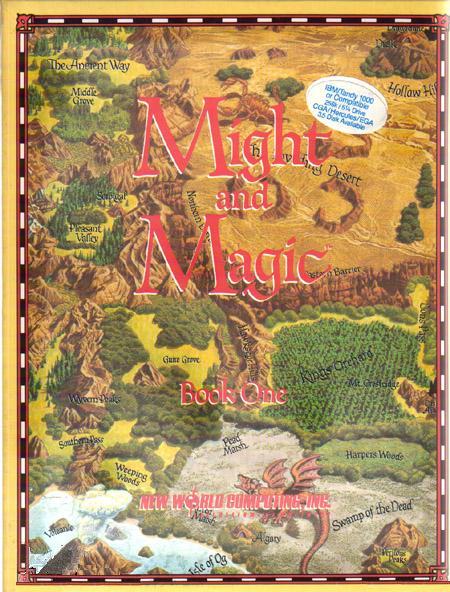
Might and Magic I: Secret of the Inner Sanctum is a classic computer RPG, originally released in 1986 for the Apple II by New World Computing and later ported to about ten different platforms. Nearly the whole game is the work of one man, Jon Van Caneghem, working out of his apartment in his spare time. Nowadays, he apparently spends most of his time making various MMORPGs.
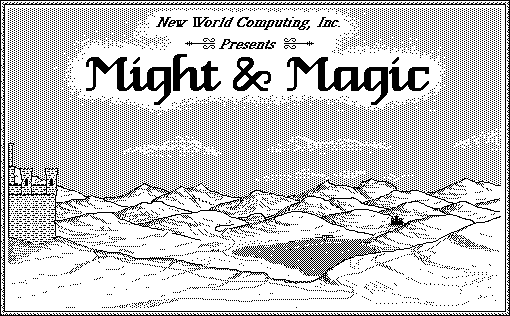
We're going to be LPing the Mac version, because I'm not playing a CRPG that doesn't have mouse support. It has black and white graphics, but trust me when I say that most of the graphics aren't really improved by the addition of colour.
Think of M&M as the somewhat gentler big brother of games like Bard's Tale and Wizardry. Rather than being set in a single city or dungeon, the quest of Might and Magic spans the entire land of Varn, with 55 different areas to explore, comprising towns, dungeons and outdoor sections. When I say "somewhat gentler", though, that's very much a relative term: the party's still gonna die a lot, but at least this game lets us return to our last save point.
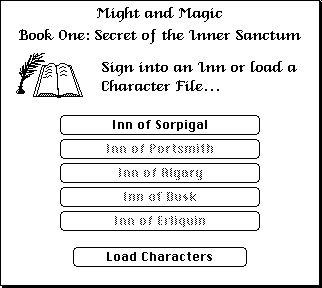
Our adventure begins in the pleasant little backwater town of Sorpigal. For an adventure, of course, we shall need adventurers!
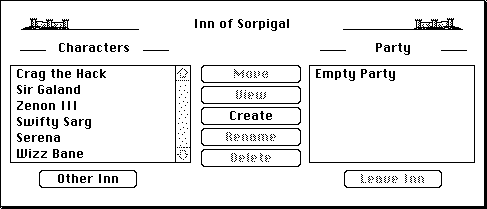
The party can have up to six members. If we wanted, we could use the pre-generated default characters, but where's the fun in that? I'll need volunteers from the audience to help create our party!

Here's the character generation screen. I think all the statistics are pretty self-explanatory, except for Personality, which affects Clerics' and Paladins' spell points. Select your class, and if you want me to prioritise certain stats over others, be sure to mention it. Here's a rundown on the six character classes:
Knight: You know what these are. They wear shining armour and hit things. Knights can use all weapons and armour, except for a few rare magical items designed exclusively for other classes. They also gain more hit points than any other class, but can't cast spells. Knights must have at least 12 Might.
Paladin: Paladins wear even shinier armour than Knights, and after enough holy crusading they can eventually please their god enough to gain low-level Cleric spells. They don't gain as many hit points as a Knight, but can still use nearly all weapons and armour. Paladins must have at least 12 Might, Personality and Endurance.
Archer: Hitting things is all very well, but what do you do when you need to hit something that's not within convenient stabbing distance? Well, you can either use a missile weapon or a spell, and Archers excel with both. They gain as many hit points as a Paladin, can use nearly all weapons, can cast low-level Sorcerer spells, and are the only class allowed to use missile weapons in melee combat. Their defensive abilities aren't so impressive, though: they can't wear any armour heavier than chain mail or use any shields. Archers must have at least 12 Intellect and Accuracy.
Cleric: Holy men and women who sweet-talk deities into letting them perform miracles. They don't gain as many hit points as the melee classes, and they're restricted to using blunt weapons, but they can wear any armour up to chain mail and use all shields. Most importantly, they can cast spells to heal and protect the party. An adventuring party without at least one Cleric shouldn't expect to survive very long. Clerics must have at least 12 Personality.
Sorcerer: Sorcerers gain the fewest HP of any class and a pitiful selection of equipment: they can only use clubs, daggers, staffs and padded armour. They make up for this with their spell list, containing a variety of powerful offensive, utility, and even protective spells. Sorcerers must have at least 12 Intellect, and they also benefit more than most classes from having high Speed.
Robber: Masters of going places they're not supposed to be and taking things they're not supposed to have. Robbers have as many HP as clerics, but have a slightly weaker selection of armour. They can use one-handed weapons and crossbows, but they don't fight as well as a Knight, Archer or Paladin, and they can't use any spells. Their most important skill is the ability to pick locks and disarm traps, which are deadly enough that it would be foolhardy to adventure without a Robber. Any character can be a Robber, but I think that high Luck improves their chance to successfully pick locks and disarm traps.
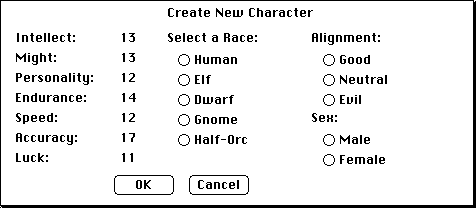
Once you've decided what class your new hero is to be, you need to select a race, alignment and sex.
Any race can belong to any class. Some are better at some classes than others, but the stat penalties aren't big enough to cripple any class/race combination. Humans have balanced stats and resistance to fear and sleep spells. Elves resist fear and have high Intellect and Accuracy, but low Might and Endurance. Dwarves resist poison and have high Endurance and Luck, but low Intellect and Speed. Gnomes resist magic and have high Luck, but low Speed and Accuracy. Half-orcs resist sleep and have high Might and Endurance, but low Intellect, Personality and Luck.
Alignment affects a character's ability to equip certain magic items, and also has a minor impact on certain quests and events: overall, it's not very important. A character's alignment can change throughout the game, based mostly on how they react to monster encounters. There's an advantage to everyone in the party having the same alignment, but it's not a big deal.
Sex is important in only one place in the game, as far as I know, but in that place it's very important. Females have an advantage over males, but don't worry: if we don't start out with enough females, we can fix that later.

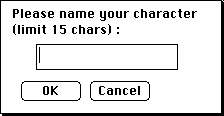
Finally, your hero will need a name, which can be up to 15 characters in length.
I think I've yammered on for long enough today. It's time to sign up, brave adventurers!
Also, thanks to DancingKittycat for this guide on how to get M&M1 running on modern computers:
DancingKittycat posted:
Its Abandonware. Quick guide to get the emulator running (from memory, so I might be forgetting something: it has been a while since I set it up):
1. Get the game from http://www.macintoshgarden.org/ - this is perfectly legal, don't worry, Thuryl linked it to me before.
2. Now you need an emulator for old, old Macs. Since I'm on an Intel Mac, I chose Mini vMac, though Basilisk II seems to be nice too. Anyway, my explanation might not apply to any other emulator than vMac.
3. Now you need a whole bunch of stuff:
- Empty, virtual Macintosh "Disks". I upped one for you here
- The vmac.rom file. Since I'm unsure about its legality (though it shouldn't be much of a problem, since Apple offers almost all old system files directly on apple.com) I won't link to it.
- MacOS 6.0.8, which you can download directly from Apple here. You are looking for two files called "SSW_6.0.8-1.4MB_Disk1of2.sea.bin" and, surprisingly enough, "-Disk2of2.sea.bin"
- Some way to use the .dsk files. I have honestly no idea how to pull it off in Windows - on a Mac, you just rename the .dsk files to .img, which lets you mount them easily afterwards, copy everything you need, unmount and rename them back to *dsk. Perhaps you can pull off something similar by renaming the disks to .img and mounting them with Daemon Tools?
4. Now you just copy the blank disk image several times, which lets you make a bunch of system disks, and a disk with Might & Magic on it (just copy everything on them once you've figured out how, nothing fancy I suppose). You can also find premade system .dsk-files somewhere on the vMac homepage, though I can't seem to find them just now.
5. Just drag&drop the disks on the emulator to mount them in your little System 6. You might want to run the setup from the system disks first (during which you'll need one more blank disk). After everything is installed, just drop your Might & Magic virtual disk on the emulator, open it and play away!
To add to this, here's a little advice on getting Basilisk II running. It's actually easier than vMac in some ways, since Basilisk II lets you create a virtual hard disk using a few hundred megabytes of disk space on your real hard drive, and also allows you to specify a folder as a shared folder between your real computer and the emulated computer (the emulated computer treats it as a network drive.) So all you have to do is install some system software on your virtual hard disk, then get a copy of Might & Magic, drag it into the shared folder and install it from there. Unfortunately, Basilisk II is a resource hog and has an occasional tendency to crash.